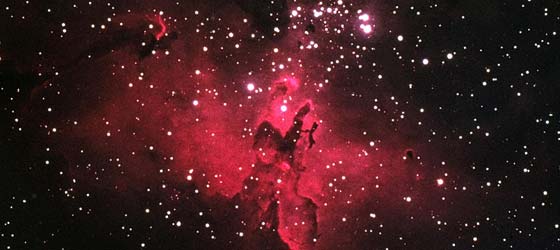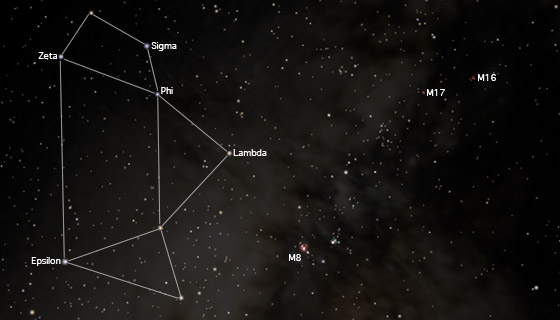
M16Basic information about M16. Its an open cluster, type e, in Serpens, also known as NGC6611. It is not the Eagle Nebula (a well known gaseous nebula in the same area, known as IC4703) but it is associated with it. The position is right ascension 18h 18.8m, and declination is -13° 47m. The distance is 7000 light years. Visual brightness is 6.4 magnitude meaning the true magnitude of the stars is about -8. The apparent size is 7 arc minutes which corresponds to a true size of about 15 light years across. The associated nebula extends much further: out to about 30' making it about 70 x 55 light years in size. The cluster was discovered by Philippe Loys de Chéseaux in 1745-6. The nebula was probably first photographed by E.E. Barnard in 1895. The cluster formed from the gas of the Eagle Nebula about 5.5 million years ago, and star formation is still occurring in the area now. High resolution images from the Hubble Space Telescope show bright and dark areas where this process occurs. Because of the size of the cluster and nebula low magnification is required to view them properly. A telescope as small as 100 mm will show at least 20 stars in the cluster and might show areas of nebulosity under good conditions. More detail, including the dark pillars, can be seen in 'scopes above 30 cm in size. 
I usually locate M16 by finding Sagittarius. That is the prominent teapot shaped constellation near the even more prominent Scorpius and in the middle of the densest part of the Milky Way. This constellation is about 15° south of the equator so it is best in the Southern Hemisphere but still good in the Northern. Locate the obvious cluster/nebula M8 and just follow the trail of stars, clusters and nebulae along the Milky Way, you will eventually reach M16 but will see many other good objects on the way! |
![[Up]](../XuShared/Up2B.jpeg)
Comment on this page: Very Useful • Quite Useful • Useless or: View Results |
||||||||||||